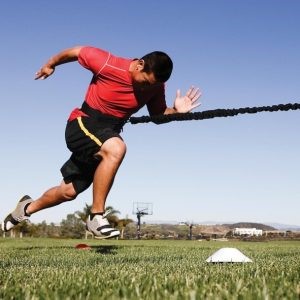Assisted sprint training
Assisted sprint training has been successfully used to advance maximum speed (Dintiman & Ward, 2003). The theory suggests that this greater than normal speed influences the nervous system to produce fast movements in a coordinated manner. This training method can help increase speed by facilitating a faster stride rate. Assisted sprint training has been shown to improve sprint times over 30 metres to 60 metres (Dintiman & Ward, 2003, Faccioni, 1995). Assisted sprint training has also been shown to improve acceleration capabilities which indicates it could be a very valuable training methodology (Upton, 2011).
Assisted sprint training methods include:
- Gravity-assisted sprinting, e.g. downhill running. Recommended grade less than 4%.
- High-speed towing, e.g. viper belt. Recommended increase in speed of less than 10%.
Downhill running or towing can cause a player to lean back and over-stride (Faccioni, 1995). The recommendations below are therefore important if the player is to prevent changes in sprinting posture. To maximise the benefits associated with assisted sprint training, coaches should emphasise:
- Arm and leg turnover
- Foot plant directly underneath the hips
- Aggressively exploding through the movement
Downhill sprinting is a safe, practical form of assisted sprint training that requires no equipment. The only difficulty would be in finding the proper slope. The ideal slope would be approximately 20 metres long with a 4% gradient and a sufficiently flat surface for acceleration before the slope and sufficiently flat surface for deceleration at the bottom of the slope. Assisted sprint training is a very demanding training method and the coach should be cautious in implementing this method. Players should display a good background of strength and conditioning as well as speed acceleration and unassisted maximum speed training before engaging in assisted maximum speed training.

Assisted sprint towing – Here we are looking for a fast arm and leg turnover to account for the towing action. Stay upright and make sure the feet are landing under the hips during the sprint.